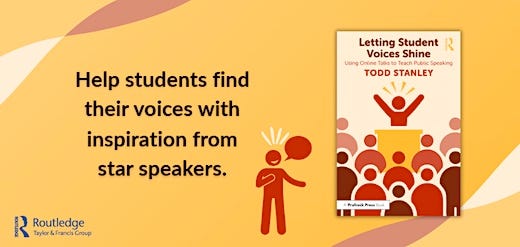MW Substack 033: Anxious Students
How can teachers and schools help anxious kids feel safer and gain more confidence as learners?
Welcome to MiddleWeb Substack. It’s a free, topical, five-minute read for middle grades educators, featuring a selection of MiddleWeb’s most popular and influential articles on a particular topic or theme, a book review, and a noteworthy 4-8 resource we’ve spotted elsewhere. That’s it!
If you’d like to support this substack newsletter (here’s the archive) and MiddleWeb.com’s mission to publish the writing of educators like you, consider becoming a $5-a-month paid subscriber.
►STUDENT ANXIETY
How do we help anxious kids feel safer and more self-confident?
“Anxiety can feel big and powerful. It can show up suddenly, without warning.” – children's writer Gabi Garcia, author of Find Your Calm.
Many educators are identifying anxiety, stress and trauma among their students as significant inhibitors of learning. As student anxiety rises and mental health issues accumulate, the danger of erasing mindfulness and reinforcing self-doubt increases.
In these nine articles from the MiddleWeb archives, veteran teachers and school support staff offer research-based strategies that can help students gain the confidence they need to succeed.
Address Student Anxiety to Boost Their Learning
Given the high level of anxiety among young people today, teachers need to focus more on students’ need for emotional safety. Gravity Goldberg suggests ways to use what we know about the body-brain connection to help kids experience the kind of emotional regulation they need for any learning to happen.
Help Kids Take Charge of Their Emotions
When our students are struggling with anxiety, they need support in developing strategies to help break down their problems. Chunking a problem and examining possible options can help make it feel more manageable. School psychologist Katelyn Oellerich shares two strategies.
Teaching Middle Grades Students to Self-Regulate
When kids struggle to avoid anxiety, stay on task, reach goals, and take ownership of their learning, they lack self-regulation. Using clear text and video explanations, Amy Gaumer Erickson and Pattie Noonan break down the four components of self-regulation that will help students succeed.
SEL Picture Books for Middle School Advisory
Providing consistent opportunities for students to learn about and practice social emotional skills in middle school advisory can aid in their behavioral and academic growth. In this popular article, teacher Kasey Short suggests 14 read-aloud picture books with questions that can support that growth.
Why It’s Hard to Teach & Parent Middle Graders
Working with kids in the middle grades has never been harder. We can’t do it alone. Building trust between parents and teachers is crucial, writes middle level leader Jody Passanisi. “When there’s trust, we can work together to support kids through anxiety, challenges and successes.”
8 Ways to Help Tweens Take Academic Risks
Students in the middle grades think in polarities and will go to stress-inducing lengths to avoid embarrassment, writes author and school counselor Phyllis Fagell. But with the right supports, they can learn to overcome anxiety and self-doubt and take risks – asking questions, joining discussions and learning more.
Using Ambient Sound to Reduce Student Stress
Social media can disrupt concentration and healthy social development in adolescents. To counter its effects, principal Mike Gaskell looks at causes and suggests one helpful strategy to increase focus and reduce stress and anxiety – ambient sound. Build the focus and flow students need to thrive.
Build a Classroom That’s Resilience-Friendly
All students can learn how to pick up the pieces after they face anxiety, adversity, disappointment, loss, or trauma and go on. They need our guidance to find healthy ways to move forward. Debbie Silver offers six strategies educators can use to create classrooms that foster resiliency.
Reassuring Routines Build Student Confidence
Unexpected events in classrooms steal precious teaching time and lead to anxious students and frustrated teachers. Expected routines provide comfort and familiarity so students can focus on the challenges of learning new things. Teacher Kelly Owens shares her routine-building strategies.
►ELSEWHERE
Brain development doesn’t take a breather in middle childhood.
Students in the “Missing Middle” (aged 6 to 12) are facing unprecedented challenges that researchers, educators and policymakers are only beginning to fully understand, say the authors of this recent article at The 74. “These trials are causing social, emotional and developmental struggles that often go unseen, yet affect everything from learning to mental health.”
►OUR BOOK REVIEW
An essential tool to help anxious kids in class.
With so many students experiencing stress, David Campos and Kathleen Fad help K-8 teachers understand anxiety and then implement strategies to help anxious adolescents. Other students can benefit, too. MS leader and teacher Kasey Short says Help Anxious Kids in a Stressful World: 25 Classroom Strategies will be an essential tool in her work. Read the complete review.



I appreciate the focus on anxiety in the classroom. Motivation is such an important aspect of the learning experience. Anxiety is the act of worrying about the future. Everyone has it, but not everyone is as skilled at managing it.
I like the strategy of making the classroom environment predictable. According to B.F. Skinner, Behavior is lawful. This refers to how every behavior is determined by environment. As a future teacher, I will remember to be reliable and predictable.
I would also like to add an emphasis on workload. I understand the importance of practice, but an excessive workload can intensify anxiety.